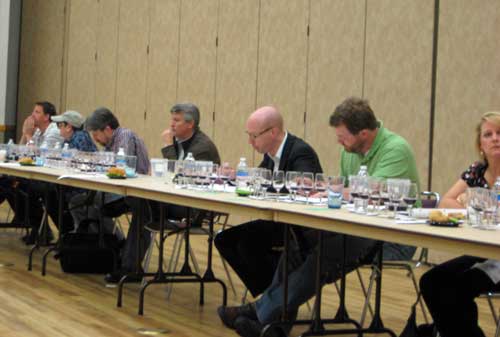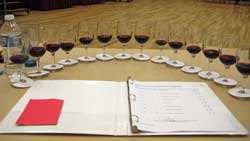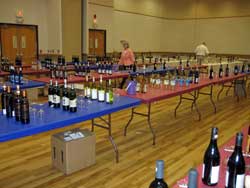
Texas Wines Earn High Marks: 2009 Lone Star International Wine Competition
Medal Results from the 2009 Lone Star International Wine Competition at: http://www.txwines.org/competitions/lonestar_results.asp
The rest of the story……
Last week, I blogged about my trek across the highways and byways of Texas from Houston up to Grapevine, Texas: An appropriate place to judge a wine competition. The blog notes my reflections on Texas terroir and my mental preparations assessing shades of arboreal green in the Texas roadside scenery, at: (https://vintagetexas.com/?p=865). The wine competition was the 2009 (26th annual) Lone Star International Wine Competition (LSIWC).
In the LSIWC, nearly 500 wines from around the world were judged in over thirty categories by a panel of restaurant owners, sommeliers and other wine experts from Texas. I guess that yours truly fits the latter category although I did successfully pass my first level Sommelier exam. The co-chairs that organized and oversaw the LSIWC were Barbara Werley, M.S., Pappas Brothers Steakhouse’s Master Sommelier and Beverage Director, the first Master Sommelier in the 26 year history of the event; and Michael Zerbach, long time chair of the event and winner of the John E. Crosby, Jr. Award for his achievements in increasing the stature and visibility of the Lone Star Wine Competition awarded by the Texas Wine and Grape Growers Association Board of Directors.
Four Competitions in One
Interestingly enough, the LSIWC is four, four, four competitions in one…. a Texas Competition, an International Competition, and a Limited Production Competition. In the spirit of the local wine movement (www.drinklocalwine.com), wines qualifying for the Texas Competition must be 75% volume from Texas grapes. Additionally, for the first time the forth facet of the LSIWC included a Rising Star award for the best showing by a young Texas wineries in red and white wine categories. This new award was underwritten by Paul and Merrill Bonarrigo of Messina Hof Winery (www.messinahof.com) in Bryan, Texas.
Before talking about the competition results, I think that a short behind-the-scenes look at the process of the competition and wine judging is interesting. The LSIWC organizes the judges into panels of about five judges. All wines presented to the judges are tasted blind; this means that the judges do not know the names of the wines or wineries. The only data about the wines visible to the judges are the blend of grapes, residual sugar content and percent alcohol. Each judge has a tasting sheet and is given four judging cards that indicate: Bronze medal, silver medal, gold medal or no medal. After tasting and judging the wines, the judges are asked to raise the cards that indicate his or her ratings for the wines in a particular flight.
Effective Techniques of Wine Evaluation: Why? Why? Why?
 I have discussed wine evaluation with many judges and in the past ten years tried different techniques myself. It is evident that there are many techniques that judges use. But, most importantly, good judges know not to judge based on their own personal likes and dislikes and rather focus on the quality of the wine. My personal approach is to try to understand the approach of the winemaker, starting my asking myself a few questions as I taste each wine. The questions are some basic WHYS. Why did the winemaker make this wine? Why did the winery submit this wine to competition? Why do I like or dislike the wine?
I have discussed wine evaluation with many judges and in the past ten years tried different techniques myself. It is evident that there are many techniques that judges use. But, most importantly, good judges know not to judge based on their own personal likes and dislikes and rather focus on the quality of the wine. My personal approach is to try to understand the approach of the winemaker, starting my asking myself a few questions as I taste each wine. The questions are some basic WHYS. Why did the winemaker make this wine? Why did the winery submit this wine to competition? Why do I like or dislike the wine?
Due to the speed of the competition (each panel tasted 70 or more wines in two sessions per day), the judging process has to be simple, direct, and most importantly accurate. I look for a few basic qualities in the wines I am judging:
1. Color and aroma of the wine
2. Balance – alcohol, fruit, acid, tannin in combination leading to a pleasant wine tasting experience
3. Presence of flaws – sulfur, musty or fingernail polish smells or cloudy appearance
4. Varietal correctness – Does a Cabernet look, smell and taste like a Cabernet
This process takes about 60 seconds per wine and is an outgrowth of what I have learned from wine expert, Kevin Zraly. He calls it his “Sixty Second Wine Expert” (See: https://vintagetexas.com/?p=417).
Based on this or similar methodologies, each judge develops a medal rating for each wine. At the end of all flights of wines, the judges present their results by showing the appropriate card. It might seem amazing, but much of the time, the judge’s ratings are bunched close together, particularly in cases of “no medal”. However, in a few cases we had divergent ratings and needed to discuss our results before coming to a final conclusion.
 After the first day’s judging, the second day was focused on a comparative judging of the highest scoring wines to compete for the Grand Star awards (best of show) in various categories. During the second day, we had two very interesting situations arise. In the first case, we were judging for the Grand Star award in a white wine category. Three wines had identical ratings from the judges. A second round of voting was held and again the judges were completely deadlocked on these three wines. At this point, we asked for a referee, Barbara Werley – M.S., to independently taste the three wines and be the tie breaker. In the second case, we were judging a flight of fifteen red wines for a Grand Star award. This was a rather large flight, which makes reaching a consensus difficult. In this flight, the judges had to vote five times to narrow down the competition to a single wine.
After the first day’s judging, the second day was focused on a comparative judging of the highest scoring wines to compete for the Grand Star awards (best of show) in various categories. During the second day, we had two very interesting situations arise. In the first case, we were judging for the Grand Star award in a white wine category. Three wines had identical ratings from the judges. A second round of voting was held and again the judges were completely deadlocked on these three wines. At this point, we asked for a referee, Barbara Werley – M.S., to independently taste the three wines and be the tie breaker. In the second case, we were judging a flight of fifteen red wines for a Grand Star award. This was a rather large flight, which makes reaching a consensus difficult. In this flight, the judges had to vote five times to narrow down the competition to a single wine.
Results of the Lone Star International Wine Competition
Further information and the medal awards from the LSIWC are available online at:
http://www.txwines.org/competitions/lonestar_results.asp
Most noteworthy were the following award winners from Texas wineries:
Texas Grand Star Winners
Fortified Wine – Haak Vineyards & Winery (www.haakwine.com), Madeira Blanc du Bois 2006
Red Table Wine – Driftwood Estate Winery (www.driftwoodvineyards.com), Lone Star Cab 2006
White Table Wine – Grape Creek Vineyards (www.grapecreek.com), Viognier – Lost Draw Vineyards 2008
Grand Star Limited Production Winner
Red Caboose Vineyard & Winery (www.redcaboosewinery.com ), Cabernet Sauvignon 2007
Texas Gold Medal Winners
Haak Vineyards & Winery (www.haakwine.com), Madeira Blanc du Bois 2006
Kiepersol Estate (www.kiepersol.com), Texas Merlot 2006
McPherson Cellars (www.mcphersoncellars.com), Grenache/Mourvedre 2007
Red Caboose Vineyard & Winery (www.redcaboosewinery.com ), Cabernet Sauvignon 2007
San Martino Winery & Vineyards (www.sanmartinowinery.com), Tempranillo 2005
If I had to pick one white and red wine from this year’s competition that were my personal favorites based on this judging, they would be Grape Creek Vineyards, Viognier – Lost Draw Vineyards 2008 and McPherson Cellars, Grenache/Mourvedre 2007. I also would like to have personal honorable mentions for the San Martino Winery & Vineyards, Tempranillo 2005 which was on my recent Grand Wine and Food Affair, Pick Six wine list (https://vintagetexas.com/?p=738), and for Kiepersol Estate, Texas Merlot 2006. These wines exemplify the necessary combination of good growing practices and winemaking judgment. It was easy to answer the WHY questions for these wines. Also, several of these wines illustrate a trend for the future for Texas wines…..The focus on warm weather varietals that ripen well during our hot, sunny Texas summers.
Texas Rising Star Award Winners
This year’s winners of the Texas Vintner’s Rising Star Awards were KE Cellars for their 4 U Syrah, 2007 red table wine and Enoch’s Stomp Vineyard & Winery for their Blanc du Bois Off-Dry white, 2008, both outstanding wines.
Reflections
Overall, the LSIWC awarded 26 gold, 81 silver and 172 bronze medals to entries from fourteen states and several foreign countries. This year’s competition was a true testament to the Drink Local Wine movement in Texas. This competition shows that despite the current period of unfriendly weather in Texas with its late spring freezes, hail, recent summertime rains, and the constant war against Pierce’s Disease, award winning wines can be made successfully through the grit, gumption and determination that define Texas’s growers and winemakers.

Be the first to comment